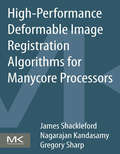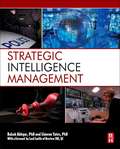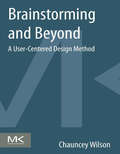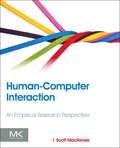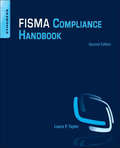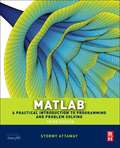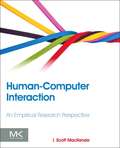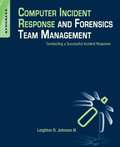- Table View
- List View
High Performance Deformable Image Registration Algorithms for Manycore Processors
by James Shackleford Nagarajan Kandasamy Gregory SharpHigh Performance Deformable Image Registration Algorithms for Manycore Processors develops highly data-parallel image registration algorithms suitable for use on modern multi-core architectures, including graphics processing units (GPUs). Focusing on deformable registration, we show how to develop data-parallel versions of the registration algorithm suitable for execution on the GPU. Image registration is the process of aligning two or more images into a common coordinate frame and is a fundamental step to be able to compare or fuse data obtained from different sensor measurements. Extracting useful information from 2D/3D data is essential to realizing key technologies underlying our daily lives. Examples include autonomous vehicles and humanoid robots that can recognize and manipulate objects in cluttered environments using stereo vision and laser sensing and medical imaging to localize and diagnose tumors in internal organs using data captured by CT/MRI scans.Demonstrates how to redesign widely used image registration algorithms so as to best expose the underlying parallelism available in these algorithmsShows how to pose and implement the parallel versions of the algorithms within the single instruction, multiple data (SIMD) model supported by GPUsProvides Programming "tricks" that can help readers develop other image processing algorithms, including registration algorithms for the GPU
Computation and Storage in the Cloud: Understanding the Trade-Offs
by Dong Yuan Yun Yang Jinjun ChenComputation and Storage in the Cloud is the first comprehensive and systematic work investigating the issue of computation and storage trade-off in the cloud in order to reduce the overall application cost. Scientific applications are usually computation and data intensive, where complex computation tasks take a long time for execution and the generated datasets are often terabytes or petabytes in size. Storing valuable generated application datasets can save their regeneration cost when they are reused, not to mention the waiting time caused by regeneration. However, the large size of the scientific datasets is a big challenge for their storage. By proposing innovative concepts, theorems and algorithms, this book will help bring the cost down dramatically for both cloud users and service providers to run computation and data intensive scientific applications in the cloud. Covers cost models and benchmarking that explain the necessary tradeoffs for both cloud providers and usersDescribes several novel strategies for storing application datasets in the cloudIncludes real-world case studies of scientific research applications Covers cost models and benchmarking that explain the necessary tradeoffs for both cloud providers and users Describes several novel strategies for storing application datasets in the cloud Includes real-world case studies of scientific research applications
Software Engineering: Architecture-driven Software Development
by Richard F SchmidtSoftware Engineering: Architecture-driven Software Development is the first comprehensive guide to the underlying skills embodied in the IEEE's Software Engineering Body of Knowledge (SWEBOK) standard. Standards expert Richard Schmidt explains the traditional software engineering practices recognized for developing projects for government or corporate systems. Software engineering education often lacks standardization, with many institutions focusing on implementation rather than design as it impacts product architecture. Many graduates join the workforce with incomplete skills, leading to software projects that either fail outright or run woefully over budget and behind schedule. Additionally, software engineers need to understand system engineering and architecture—the hardware and peripherals their programs will run on. This issue will only grow in importance as more programs leverage parallel computing, requiring an understanding of the parallel capabilities of processors and hardware. This book gives both software developers and system engineers key insights into how their skillsets support and complement each other. With a focus on these key knowledge areas, Software Engineering offers a set of best practices that can be applied to any industry or domain involved in developing software products.A thorough, integrated compilation on the engineering of software products, addressing the majority of the standard knowledge areas and topics Offers best practices focused on those key skills common to many industries and domains that develop software Learn how software engineering relates to systems engineering for better communication with other engineering professionals within a project environment
School Security: How to Build and Strengthen a School Safety Program
by Paul TimmIt seems that every day there’s a new story about a security lapse, emergency lock-down, or violent act taking place at a school somewhere in the United States. Today it’s simply inexcusable not to have adequate security measures in place—regardless of how safe you think your community may be. In School Security, author Paul Timm, a nationally acclaimed school security expert, explains how to make your institution a safer place to learn with easy-to-follow steps. Throughout the book, Timm emphasizes a proactive rather than reactive approach to school security. Readers are introduced to basic loss prevention and safety concepts, including how to communicate safety information to students and staff, how to raise security awareness, and how to prepare for emergencies. The book discusses how to positively influence student behavior, lead staff training programs, and write sound security policies. An entire chapter is dedicated to describing what school security resources are available for follow-up reading and further training. School Security isn’t just a book for security professionals: it helps people without formal security training—namely, educators and school administrators—effectively address school risk. Serves as a comprehensive guide for building an effective security program at little or no cost. Covers fundamental crime prevention concepts, making it suitable for both school security professionals and educators with no formal security training. Addresses the risks commonly facing school administrators today, from access control to social media. Takes a holistic approach to school security rather than focusing on a particular threat or event.
Computer Organization and Design: The Hardware/Software Interface (Fifth Edition) (PDF)
by David Patterson John HennessyThe 5th edition of Computer Organization and Design moves forward into the post-PC era with new examples, exercises, and material highlighting the emergence of mobile computing and the cloud. This generational change is emphasized and explored with updated content featuring tablet computers, cloud infrastructure, and the ARM (mobile computing devices) and x86 (cloud computing) architectures. Because an understanding of modern hardware is essential to achieving good performance and energy efficiency, this edition adds a new concrete example, "Going Faster," used throughout the text to demonstrate extremely effective optimization techniques. Also new to this edition is discussion of the "Eight Great Ideas" of computer architecture. As with previous editions, a MIPS processor is the core used to present the fundamentals of hardware technologies, assembly language, computer arithmetic, pipelining, memory hierarchies and I/O.
The Digital Crown: Winning at Content on the Web
by Ahava LeibtagIn 1997, Bill Gates famously said "Content is king." Since then, the digital marketing world has been scrambling to fulfill this promise, as we finally shift our focus to what consumers really want from our brands: a conversation.The Digital Crown walks you through the essentials of crafting great content: the fundamentals of branding, messaging, business goal alignment, and creating portable, mobile content that is future-ready. Systems create freedom, and within this book you’ll learn the seven critical rules to align your internal and external content processes, including putting your audience first, involving stakeholders early and often, and creating multidisciplinary content teams. Complete with case studies and experience drawn directly from global content projects, you are invited to observe the inner workings of successful content engagements. You’ll learn how to juggle the demands of IT, design, and content teams, while acquiring all the practical tools you need to devise a roadmap for connecting and engaging with your customers. This is your next step on the journey to creating and managing winning content to engage your audience and keep them coming back for more.Discover easy-to-follow, simple breakdowns of the major ideas behind engaging with your customerLearn both the theoretical and practical applications of content and communication on-lineMaximize on the case studies and real-world examples, enabling you to find the best fit for your own business
Joe Celko’s Complete Guide to NoSQL: What Every SQL Professional Needs to Know about Non-Relational Databases
by Joe CelkoJoe Celko's Complete Guide to NoSQL provides a complete overview of non-relational technologies so that you can become more nimble to meet the needs of your organization. As data continues to explode and grow more complex, SQL is becoming less useful for querying data and extracting meaning. In this new world of bigger and faster data, you will need to leverage non-relational technologies to get the most out of the information you have. Learn where, when, and why the benefits of NoSQL outweigh those of SQL with Joe Celko's Complete Guide to NoSQL. This book covers three areas that make today's new data different from the data of the past: velocity, volume and variety. When information is changing faster than you can collect and query it, it simply cannot be treated the same as static data. Celko will help you understand velocity, to equip you with the tools to drink from a fire hose. Old storage and access models do not work for big data. Celko will help you understand volume, as well as different ways to store and access data such as petabytes and exabytes. Not all data can fit into a relational model, including genetic data, semantic data, and data generated by social networks. Celko will help you understand variety, as well as the alternative storage, query, and management frameworks needed by certain kinds of data.Gain a complete understanding of the situations in which SQL has more drawbacks than benefits so that you can better determine when to utilize NoSQL technologies for maximum benefit Recognize the pros and cons of columnar, streaming, and graph databases Make the transition to NoSQL with the expert guidance of best-selling SQL expert Joe Celko
Strategic Intelligence Management: National Security Imperatives and Information and Communications Technologies
by Babak Akhgar Simeon YatesStrategic Intelligence Management introduces both academic researchers and law enforcement professionals to contemporary issues of national security and information management and analysis. This contributed volume draws on state-of-the-art expertise from academics and law enforcement practitioners across the globe. The chapter authors provide background, analysis, and insight on specific topics and case studies. Strategic Intelligent Management explores the technological and social aspects of managing information for contemporary national security imperatives. Academic researchers and graduate students in computer science, information studies, social science, law, terrorism studies, and politics, as well as professionals in the police, law enforcement, security agencies, and government policy organizations will welcome this authoritative and wide-ranging discussion of emerging threats.Hot topics like cyber terrorism, Big Data, and Somali pirates, addressed in terms the layperson can understand, with solid research groundingFills a gap in existing literature on intelligence, technology, and national security
Federated Identity Primer
by Derrick RountreeIdentity authentication and authorization are integral tasks in today's digital world. As businesses become more technologically integrated and consumers use more web services, the questions of identity security and accessibility are becoming more prevalent. Federated identity links user credentials across multiple systems and services, altering both the utility and security landscape of both. In Federated Identity Primer, Derrick Rountree.Learn about Internet authenticationLearn about federated authenticationLearn about ADFS 2.0
Relevance Ranking for Vertical Search Engines
by Yi Chang Bo LongIn plain, uncomplicated language, and using detailed examples to explain the key concepts, models, and algorithms in vertical search ranking, Relevance Ranking for Vertical Search Engines teaches readers how to manipulate ranking algorithms to achieve better results in real-world applications. This reference book for professionals covers concepts and theories from the fundamental to the advanced, such as relevance, query intention, location-based relevance ranking, and cross-property ranking. It covers the most recent developments in vertical search ranking applications, such as freshness-based relevance theory for new search applications, location-based relevance theory for local search applications, and cross-property ranking theory for applications involving multiple verticals. Foreword by Ron Brachman, Chief Scientist and Head, Yahoo! LabsIntroduces ranking algorithms and teaches readers how to manipulate ranking algorithms for the best resultsCovers concepts and theories from the fundamental to the advancedDiscusses the state of the art: development of theories and practices in vertical search ranking applicationsIncludes detailed examples, case studies and real-world situations
Web Services, Service-Oriented Architectures, and Cloud Computing: The Savvy Manager's Guide (The Savvy Manager's Guides)
by Douglas K. BarryWeb Services, Service-Oriented Architectures, and Cloud Computing is a jargon-free, highly illustrated explanation of how to leverage the rapidly multiplying services available on the Internet. The future of business will depend on software agents, mobile devices, public and private clouds, big data, and other highly connected technology. IT professionals will need to evaluate and combine online services into service-oriented architectures (SOA), often depending on Web services and cloud computing. This can mean a fundamental shift away from custom software and towards a more nimble use of semantic vocabularies, middle-tier systems, adapters and other standardizing aspects. This book is a guide for the savvy manager who wants to capitalize on this technological revolution. It begins with a high-level example of how an average person might interact with a service-oriented architecture, and progresses to more detail, discussing technical forces driving adoption and how to manage technology, culture and personnel issues that can arise during adoption. An extensive reference section provides quick access to commonly used terms and concepts.Broad, non-technical explanation of a technical topic for managers at all levelsOnly web services book to cover data management and software engineering perspectives; excellent resource for all members of IT teamsProvides a set of leadership principles and suggested applications for using this technology
Brainstorming and Beyond: A User-Centered Design Method
by Chauncey WilsonBrainstorming and Beyond describes the techniques for generating ideas verbally, in writing, or through sketches. The first chapter focuses on brainstorming, the foundation method for ideation, which is a complex social process building off of social psychology principles, motivational constructs, and corporate culture. Brainstorming is commonly portrayed as an easy way to generate ideas, but in reality, it is a complex social process that is often flawed in ways that are not self-evident. Chapter 2 discusses Brainwriting, which is a variation on brainstorming in which each person writes ideas down on paper and then passes the paper to a new person who reads the first set of ideas and adds new ones. Since there is no group shouting out of ideas, strong facilitation skills are not required, and more often than not, Brainwriting results greatly exceed those of group brainstorming in a shorter time because ideas are generated in a parallel, rather than serial, fashion. Brainwriting is useful when time is limited, groups are hostile, or you are dealing with a culture where shouting out wild or divergent ideas might be difficult. Finally, in Chapter 3, readers learn about Braindrawing, a method of visual brainstorming that helps practitioners generate ideas for icons, other graphics, user interface layouts, or Web page designs. Each of these methods provides readers with ways to generate, present, and evaluate ideas so they can begin building a strong foundation for product success. Learn the proper techniques for generating ideas with limited time, hostile audiences, and limited facilitation supportExplores efficient processes for analyzing the value of ideasExamines ways to generate visual as well as textual ideas
Human-Computer Interaction: An Empirical Research Perspective
by I. Scott MacKenzieHuman-Computer Interaction: An Empirical Research Perspective is the definitive guide to empirical research in HCI. The book begins with foundational topics including historical context, the human factor, interaction elements, and the fundamentals of science and research. From there, you'll progress to learning about the methods for conducting an experiment to evaluate a new computer interface or interaction technique. There are detailed discussions and how-to analyses on models of interaction, focusing on descriptive models and predictive models. Writing and publishing a research paper is explored with helpful tips for success. Throughout the book, you'll find hands-on exercises, checklists, and real-world examples. This is your must-have, comprehensive guide to empirical and experimental research in HCI—an essential addition to your HCI library. Master empirical and experimental research with this comprehensive, A-to-Z guide in a concise, hands-on referenceDiscover the practical and theoretical ins-and-outs of user studiesFind exercises, takeaway points, and case studies throughout
Data Warehousing in the Age of Big Data (The Morgan Kaufmann Series on Business Intelligence)
by Krish KrishnanData Warehousing in the Age of the Big Data will help you and your organization make the most of unstructured data with your existing data warehouse. As Big Data continues to revolutionize how we use data, it doesn't have to create more confusion. Expert author Krish Krishnan helps you make sense of how Big Data fits into the world of data warehousing in clear and concise detail. The book is presented in three distinct parts. Part 1 discusses Big Data, its technologies and use cases from early adopters. Part 2 addresses data warehousing, its shortcomings, and new architecture options, workloads, and integration techniques for Big Data and the data warehouse. Part 3 deals with data governance, data visualization, information life-cycle management, data scientists, and implementing a Big Data–ready data warehouse. Extensive appendixes include case studies from vendor implementations and a special segment on how we can build a healthcare information factory. Ultimately, this book will help you navigate through the complex layers of Big Data and data warehousing while providing you information on how to effectively think about using all these technologies and the architectures to design the next-generation data warehouse.Learn how to leverage Big Data by effectively integrating it into your data warehouse. Includes real-world examples and use cases that clearly demonstrate Hadoop, NoSQL, HBASE, Hive, and other Big Data technologies Understand how to optimize and tune your current data warehouse infrastructure and integrate newer infrastructure matching data processing workloads and requirements
FISMA Compliance Handbook: Second Edition
by Laura P. TaylorThis comprehensive book instructs IT managers to adhere to federally mandated compliance requirements. FISMA Compliance Handbook Second Edition explains what the requirements are for FISMA compliance and why FISMA compliance is mandated by federal law. The evolution of Certification and Accreditation is discussed. This book walks the reader through the entire FISMA compliance process and includes guidance on how to manage a FISMA compliance project from start to finish. The book has chapters for all FISMA compliance deliverables and includes information on how to conduct a FISMA compliant security assessment. Various topics discussed in this book include the NIST Risk Management Framework, how to characterize the sensitivity level of your system, contingency plan, system security plan development, security awareness training, privacy impact assessments, security assessments and more. Readers will learn how to obtain an Authority to Operate for an information system and what actions to take in regards to vulnerabilities and audit findings. FISMA Compliance Handbook Second Edition, also includes all-new coverage of federal cloud computing compliance from author Laura Taylor, the federal government’s technical lead for FedRAMP, the government program used to assess and authorize cloud products and services. Includes new information on cloud computing compliance from Laura Taylor, the federal government’s technical lead for FedRAMPIncludes coverage for both corporate and government IT managersLearn how to prepare for, perform, and document FISMA compliance projectsThis book is used by various colleges and universities in information security and MBA curriculums
Matlab: A Practical Introduction To Programming And Problem Solving (PDF)
by Stormy AttawayMATLAB has become the standard software tool for solving scientific and engineering problems due to its powerful built-in functions and its ability to program. Assuming no knowledge of programming, this book guides the reader through both programming and built-in functions to easily exploit MATLAB's extensive capabilities for tackling engineering problems. The book starts with programming concepts, such as variables, assignments, and selection statements, moves on to loops, and then solves problems using both the programming concept and the power of MATLAB. In-depth coverage is given to input/output, a topic fundamental to many engineering applications. The third edition of MATLAB: A Practical Introduction to Programming and Problem Solving has been updated to reflect the functionality of the current version of MATLAB. It features new and revised end-of-chapter exercises, stronger coverage of loops and vectorizing, and more engineering applications to help the reader learn this software tool in context. Presents programming concepts and MATLAB built-in functions side-by-side Systematic, step-by-step approach, building on concepts throughout the book, facilitating easier learning Sections on common pitfalls and programming guidelines direct students towards best practice
Human-Computer Interaction: An Empirical Research Perspective (PDF)
by I. Scott MackenzieHuman-Computer Interaction: An Empirical Research Perspective is the definitive guide to empirical research in HCI. The book begins with foundational topics including historical context, the human factor, interaction elements, and the fundamentals of science and research.
Total Information Risk Management: Maximizing the Value of Data and Information Assets
by Ajith Kumar Parlikad Alexander Borek Jela Webb Philip WoodallHow well does your organization manage the risks associated with information quality? Managing information risk is becoming a top priority on the organizational agenda. The increasing sophistication of IT capabilities along with the constantly changing dynamics of global competition are forcing businesses to make use of their information more effectively. Information is becoming a core resource and asset for all organizations; however, it also brings many potential risks to an organization, from strategic, operational, financial, compliance, and environmental to societal. If you continue to struggle to understand and measure how information and its quality affects your business, this book is for you. This reference is in direct response to the new challenges that all managers have to face. Our process helps your organization to understand the "pain points" regarding poor data and information quality so you can concentrate on problems that have a high impact on core business objectives. This book provides you with all the fundamental concepts, guidelines and tools to ensure core business information is identified, protected and used effectively, and written in a language that is clear and easy to understand for non-technical managers. Shows how to manage information risk using a holistic approach by examining information from all sourcesOffers varied perspectives of an author team that brings together academics, practitioners and researchers (both technical and managerial) to provide a comprehensive guideProvides real-life case studies with practical insight into the management of information risk and offers a basis for broader discussion among managers and practitioners
Analyzing the Social Web
by Jennifer GolbeckAnalyzing the Social Web provides a framework for the analysis of public data currently available and being generated by social networks and social media, like Facebook, Twitter, and Foursquare. Access and analysis of this public data about people and their connections to one another allows for new applications of traditional social network analysis techniques that let us identify things like who are the most important or influential people in a network, how things will spread through the network, and the nature of peoples' relationships. Analyzing the Social Web introduces you to these techniques, shows you their application to many different types of social media, and discusses how social media can be used as a tool for interacting with the online public. Presents interactive social applications on the web, and the types of analysis that are currently conducted in the study of social media. Covers the basics of network structures for beginners, including measuring methods for describing nodes, edges, and parts of the network. Discusses the major categories of social media applications or phenomena and shows how the techniques presented can be applied to analyze and understand the underlying data. Provides an introduction to information visualization, particularly network visualization techniques, and methods for using them to identify interesting features in a network, generate hypotheses for analysis, and recognize patterns of behavior. Includes a supporting website with lecture slides, exercises, and downloadable social network data sets that can be used can be used to apply the techniques presented in the book.
The Basics of Cloud Computing: Understanding the Fundamentals of Cloud Computing in Theory and Practice
by Derrick Rountree Ileana CastrilloAs part of the Syngress Basics series, The Basics of Cloud Computing provides readers with an overview of the cloud and how to implement cloud computing in their organizations. Cloud computing continues to grow in popularity, and while many people hear the term and use it in conversation, many are confused by it or unaware of what it really means. This book helps readers understand what the cloud is and how to work with it, even if it isn’t a part of their day-to-day responsibility. Authors Derrick Rountree and Ileana Castrillo explains the concepts of cloud computing in practical terms, helping readers understand how to leverage cloud services and provide value to their businesses through moving information to the cloud. The book will be presented as an introduction to the cloud, and reference will be made in the introduction to other Syngress cloud titles for readers who want to delve more deeply into the topic. This book gives readers a conceptual understanding and a framework for moving forward with cloud computing, as opposed to competing and related titles, which seek to be comprehensive guides to the cloud. Provides a sound understanding of the cloud and how it worksDescribes both cloud deployment models and cloud services models, so you can make the best decisions for deploymentPresents tips for selecting the best cloud services providers
Heterogeneous Computing with OpenCL: Revised OpenCL 1.2 Edition
by David R. Kaeli Perhaad Mistry Dana Schaa Benedict Gaster Lee HowesHeterogeneous Computing with OpenCL, Second Edition teaches OpenCL and parallel programming for complex systems that may include a variety of device architectures: multi-core CPUs, GPUs, and fully-integrated Accelerated Processing Units (APUs) such as AMD Fusion technology. It is the first textbook that presents OpenCL programming appropriate for the classroom and is intended to support a parallel programming course. Students will come away from this text with hands-on experience and significant knowledge of the syntax and use of OpenCL to address a range of fundamental parallel algorithms. Designed to work on multiple platforms and with wide industry support, OpenCL will help you more effectively program for a heterogeneous future. Written by leaders in the parallel computing and OpenCL communities, Heterogeneous Computing with OpenCL explores memory spaces, optimization techniques, graphics interoperability, extensions, and debugging and profiling. It includes detailed examples throughout, plus additional online exercises and other supporting materials that can be downloaded at http://www.heterogeneouscompute.org/?page_id=7 This book will appeal to software engineers, programmers, hardware engineers, and students/advanced students.Explains principles and strategies to learn parallel programming with OpenCL, from understanding the four abstraction models to thoroughly testing and debugging complete applications.Covers image processing, web plugins, particle simulations, video editing, performance optimization, and more.Shows how OpenCL maps to an example target architecture and explains some of the tradeoffs associated with mapping to various architecturesAddresses a range of fundamental programming techniques, with multiple examples and case studies that demonstrate OpenCL extensions for a variety of hardware platforms
The Basics of Cyber Warfare: Understanding the Fundamentals of Cyber Warfare in Theory and Practice
by Jason Andress Steve WinterfeldThe Basics of Cyber Warfare provides readers with fundamental knowledge of cyber war in both theoretical and practical aspects. This book explores the principles of cyber warfare, including military and cyber doctrine, social engineering, and offensive and defensive tools, tactics and procedures, including computer network exploitation (CNE), attack (CNA) and defense (CND). Readers learn the basics of how to defend against espionage, hacking, insider threats, state-sponsored attacks, and non-state actors (such as organized criminals and terrorists). Finally, the book looks ahead to emerging aspects of cyber security technology and trends, including cloud computing, mobile devices, biometrics and nanotechnology. The Basics of Cyber Warfare gives readers a concise overview of these threats and outlines the ethics, laws and consequences of cyber warfare. It is a valuable resource for policy makers, CEOs and CIOs, penetration testers, security administrators, and students and instructors in information security.Provides a sound understanding of the tools and tactics used in cyber warfare. Describes both offensive and defensive tactics from an insider's point of view. Presents doctrine and hands-on techniques to understand as cyber warfare evolves with technology.
Distributed Computing Through Combinatorial Topology
by Sergio Rajsbaum Maurice Herlihy Dmitry KozlovDistributed Computing Through Combinatorial Topology describes techniques for analyzing distributed algorithms based on award winning combinatorial topology research. The authors present a solid theoretical foundation relevant to many real systems reliant on parallelism with unpredictable delays, such as multicore microprocessors, wireless networks, distributed systems, and Internet protocols. Today, a new student or researcher must assemble a collection of scattered conference publications, which are typically terse and commonly use different notations and terminologies. This book provides a self-contained explanation of the mathematics to readers with computer science backgrounds, as well as explaining computer science concepts to readers with backgrounds in applied mathematics. The first section presents mathematical notions and models, including message passing and shared-memory systems, failures, and timing models. The next section presents core concepts in two chapters each: first, proving a simple result that lends itself to examples and pictures that will build up readers' intuition; then generalizing the concept to prove a more sophisticated result. The overall result weaves together and develops the basic concepts of the field, presenting them in a gradual and intuitively appealing way. The book's final section discusses advanced topics typically found in a graduate-level course for those who wish to explore further. Named a 2013 Notable Computer Book for Computing Methodologies by Computing ReviewsGathers knowledge otherwise spread across research and conference papers using consistent notations and a standard approach to facilitate understandingPresents unique insights applicable to multiple computing fields, including multicore microprocessors, wireless networks, distributed systems, and Internet protocols Synthesizes and distills material into a simple, unified presentation with examples, illustrations, and exercises
Computer Incident Response and Forensics Team Management: Conducting a Successful Incident Response
by Leighton JohnsonComputer Incident Response and Forensics Team Management provides security professionals with a complete handbook of computer incident response from the perspective of forensics team management. This unique approach teaches readers the concepts and principles they need to conduct a successful incident response investigation, ensuring that proven policies and procedures are established and followed by all team members. Leighton R. Johnson III describes the processes within an incident response event and shows the crucial importance of skillful forensics team management, including when and where the transition to forensics investigation should occur during an incident response event. The book also provides discussions of key incident response components.Provides readers with a complete handbook on computer incident response from the perspective of forensics team managementIdentify the key steps to completing a successful computer incident response investigationDefines the qualities necessary to become a successful forensics investigation team member, as well as the interpersonal relationship skills necessary for successful incident response and forensics investigation teams
Principles of Big Data: Preparing, Sharing, and Analyzing Complex Information
by Jules J. BermanPrinciples of Big Data helps readers avoid the common mistakes that endanger all Big Data projects. By stressing simple, fundamental concepts, this book teaches readers how to organize large volumes of complex data, and how to achieve data permanence when the content of the data is constantly changing. General methods for data verification and validation, as specifically applied to Big Data resources, are stressed throughout the book. The book demonstrates how adept analysts can find relationships among data objects held in disparate Big Data resources, when the data objects are endowed with semantic support (i.e., organized in classes of uniquely identified data objects). Readers will learn how their data can be integrated with data from other resources, and how the data extracted from Big Data resources can be used for purposes beyond those imagined by the data creators. Learn general methods for specifying Big Data in a way that is understandable to humans and to computersAvoid the pitfalls in Big Data design and analysisUnderstand how to create and use Big Data safely and responsibly with a set of laws, regulations and ethical standards that apply to the acquisition, distribution and integration of Big Data resources
